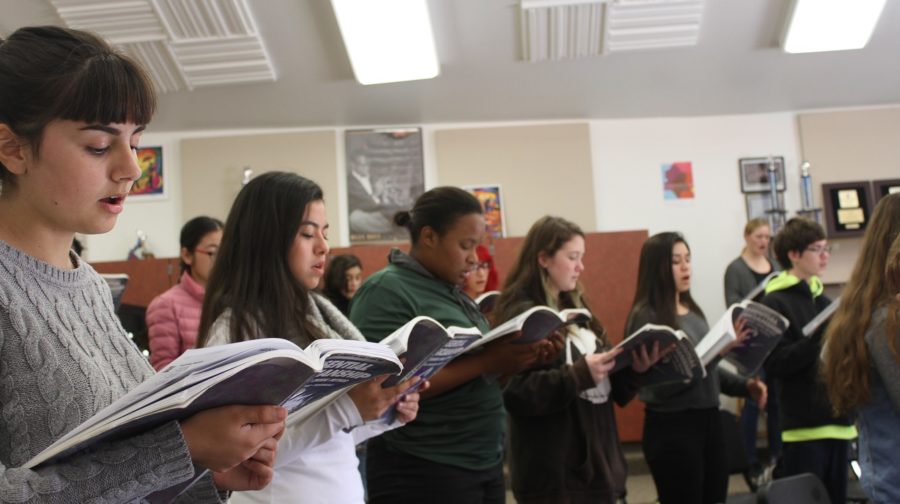Choir
This class combines singing and a welcoming environment to create an atmosphere unlike any other class. From concert to chamber choir, there are many ways for students to participate, perform, and learn about music.
Society often says that in order to be a singer, you must possess a stunning voice that uplifts and exhilarates people. While most would envision a breathtaking solo when picturing a singing performance, the powerful harmony of a dozen voices in unison cannot be discredited. Choir uses the talents of many students in order to give the audience an unforgettable experience. However, the class accepts students who don’t have professional singing experience and encourages students who are interested in music to join. Choir teacher Sean Millard emphasizes that choir has a place for everyone, whether in the concert or chamber level class.
“Concert [choir] is the entry level class — you don’t need any experience to be in there, but there are students who have sung before. For anyone who likes singing or singing with other people, that’s their entry point. Chamber is the intermediate or advanced class. They have to know how to read music on a basic level; they have to have sung in concert previously, or have enough experience singing in groups outside of school where I am convinced they will fit in. We work faster, and the music is a little bit more difficult. There are more expectations,” said Millard.
Students come from a variety of musical backgrounds and vocal strengths, and one of the most enjoyable and enduring aspects of choir is the diverse people who make up the class itself. Singing is said to be a universal language, and it’s clear that this message resonates with students from all corners of campus: from athletes to AcDec competitors, the welcoming atmosphere of the class is underscored by its appeal to all sections of the student body. Senior Nicole Stanley, a two-year chamber choir alumnus, shares her thoughts on what gives the class such an inviting aura.
“It’s more of a fun get-together than a class, because you don’t have to worry about getting a good grade just as long as you’re having fun. It’s nice to have people who like to sing as much as me. The class is informational and fun at the same time, with a bunch of great people and a really accepting environment,” said Stanley.
That environment does not merely exist in the chamber section; concert choir boasts the same laid-back feel. Two-year concert choir member and sophomore Alex Lyons describes how the choir “family” operates.
“We sing for each other and it’s really supportive. You can go in there and not worry about being judged. Mr. Millard always says to ‘leave your attitude at the door,’ and it really happens,” said Lyons.
Senior Zachary Parreira, another two-year member of the chamber section, concurred that the atmosphere is what makes the class truly special. After being introduced to music at school through venues like the drama department and clubs like Casapella, Parreira found that choir offered everything he was looking for.
“Sophomore year I was in a school musical, ‘Mrs. Bob Cratchit’s Wild Christmas Binge,’ and a couple people from Casapella came and said, ‘Hey, you should join Casapella!’ Then Mr. Millard said, ‘Hey, you should join choir!’ It’s a whole class to get away from your general education requirements and all that, just enjoying music and enjoying life. My favorite part of choir is hanging around people that you can call family. In other classes, there’s not really a connection, but in choir we have to collaborate and work together to be one group,” said Parreira.
There is a bit of a stigma surrounding the idea that singing isn’t really a “boy thing,” and that expressing yourself through music is something only girls do. But on the contrary, having boys in choir can support and balance out the music while performing in front of a large audience. Their deep vocal ranges and strengths can help round out the choir as a whole. Millard explains some crucial reasons as to why boys are vital and relevant in the choir group.
“We need guys, and guys can sing well. We have plenty of girls and I’ll take more girls too, but we need more guys to give it that full, well-rounded sound. It sounds so much better that way. We have 30 students in chamber choir, and for the first time, like eight of them are guys. That’s the most I’ve ever had proportionally in one class; we’re doing music now we’ve never been able to do, and they are all loving it,” said Millard.
Music has worldwide appeal, and choir demonstrates this through singing songs of different languages. The class takes on the challenge of performing authentic interpretations of songs in Hebrew, Gaelic, Russian, and multiple African dialects, just to name a few. Foreign language pieces are just one example of the type of music choir tackles: the class also covers classical choral work (like Beethoven and Mozart), American folk songs like “Oh Susanna,” and even pop music. The wide range of music, coupled with various festivals and concerts throughout the year, keeps the class interesting, entertaining, and educational. Stanley recounts a usual day in the choir classroom.
“We do breathing exercises and stretches, and then we do warmups with our pianist, Lauren. Then we go through our method books and learn about chords and different types of music, and we sing the songs we’re preparing for our competitions this semester,” said Stanley.
But choir isn’t all music theory, quarter notes, and pitch-matching. At its core, music is a way to bring people together and reach past the boundaries that so often divide us as a community.
“I tell them that music is meant to make people happy and hit them on an emotional level. So we try to figure -out how to get below the surface level to the emotional content of a song, and take the audience on a journey. I think there is something very personal about singing. You get a bunch of people singing together and it clicks — it is a euphoric feeling you cannot match. What you do as a group, you cannot recreate by yourself,” said Millard.







